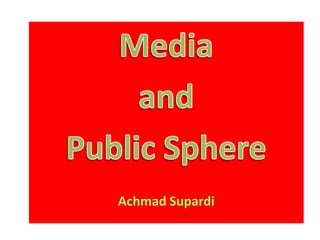
media and public sphere
- 2. The Flow of Political Interests and Influence in Democratic Landscape (Achmad Supardi) Interest Groups ------------------Spheres of Influence-----------Target of Influence Media Pressure Groups Structural Political (NGOs, Associations) Representatives (Parliament) Lobby groups Media Citizens Political Party Political Party Politicians Feedback (Input Feedback and Vote) (Input)
- 3. Public Sphere German sociologist, Jürgen Habermas “By the public sphere we mean first of all a realm of our social life in which something approaching public opinion can be formed.... Citizens behave as a public body when they confer in an unrestricted fashion – that is, within the guarantee of freedom of assembly and association and the freedom to express and publish their opinions” (cited in Pusey 1978: 89)
- 4. Public Sphere Gripsund “a set of institutions representing a sort of ‘buffer zone’ between the state/king and private sphere, to protect them from arbitrary decisions that interfered with what they considered private activities in an irrational way” (1992: 89). The press in particular ‘was to function as an instrument or a forum for the enlightened, rational, critical, and unbiased public discussion of what the common interests were in matters of culture and politics’ (ibid.) Josef Ernst “distinctive discursive space” within which “individuals are combined so as to be able to assume the role of a politically powerful force” (1988: 47). McNair (2003: 21) “the bourgeois realm of politics” (Ernst 1988: 47) which has gradually expanded from its elitist beginnings to include absolute majorities of the population in modern democratic societies.
- 5. Public Sphere McNair The public sphere, as can be seen, comprises in essence the communicative institutions of a society, through which facts and opinions circulate and by means of which a common stock of knowledge is built up as the basis for collective political action (2003: 20-21) Hence, the mass media, which since the eighteenth century have evolved into the main source and focus of a society’s shared experience played a significant role in the public sphere (McNair: 2003: 20-21).
- 6. Public Opinion Media became the most influential actor in influencing public opinion. According to Habermas, the first use of the term ‘public opinion’ was documented in 1781, referring to “the critical reflection of a [bourgeois] public competent to form its own judgments” (Pusey 1978: 90).
- 7. Generally, the media is the most influential actor in determining public opinion. Other actors are pressure groups Pressure groups Pressure groups “have been credited with having developed new styles of political activism, the so- called ‘new politics’ – popular protests, marches, sit- ins, direct action, and so on – that has proved to be attractive to a growing body of young people disillusioned by ‘conventional’ politics”*. Conventional politics: politics through parliament by means of political parties
- 8. Group Interests Pressure groups and political parties “Pressure groups and political parties have much in common. They are the two main bodies through which the public’s views and interests are channelled to government. As such, both of them carry out representation, facilitate political participation and contribute to the policy process. However, on the face of it, groups and parties are very different beasts” (http://www.palgrave.com/PDFs/0230201733.pdf).
- 9. Group Interests A pressure group is an organized group of people which aims to influence the policies or actions of government. Pressure groups are defined by three key features: 1) They seek to exert influence from outside, rather than to win or exercise government power. Pressure groups do not make policy decisions, but rather try to influence those who do (the policy-makers). In that sense, they are ‘external’ to government. 2) They typically have a narrow issue focus. In some cases, they may focus on a single issue (for instance opposing a planned road development). 3) Their members are united by either a shared belief in a particular cause or a common set of interests. People with different ideological and party preferences may thus work happily together as members of the same pressure group. (http://www.palgrave.com/PDFs/0230201733.pdf).
- 10. Group Interests Examples of Pressure Groups: Indonesia 1. 2. 3. 4. 5. 6. International 1. 2. 3. 4.
- 11. The Flow of Political Interests and Influence in Democratic Landscape (Achmad Supardi) Interest Groups ------------------Spheres of Influence-----------Target of Influence Media Pressure Groups Structural Political (NGOs, Associations) Representatives (Parliament) Lobby groups Media Citizens Political Party Political Party Politicians Feedback (Input Feedback and Vote) (Input)
- 12. Media and Public Discourse The scheme above indicated that media hold two positions: 1) Media as one of interest groups 2) Media as public sphere of discourse Media as ‘disseminators’ as well as ‘directors’ ** Media Ideology determines the choices of topics and editorial policy political stance ** Media Ownership the owner’s interest and future goals Public Discourse Anti-Trust Regulations
- 14. What trigger the emergence of individual broadcasters? What are the impacts of individual broadcasters for political campaign? What are the effects of individual broadcasters for government/policy- makers, media, industry, and interest groups?
